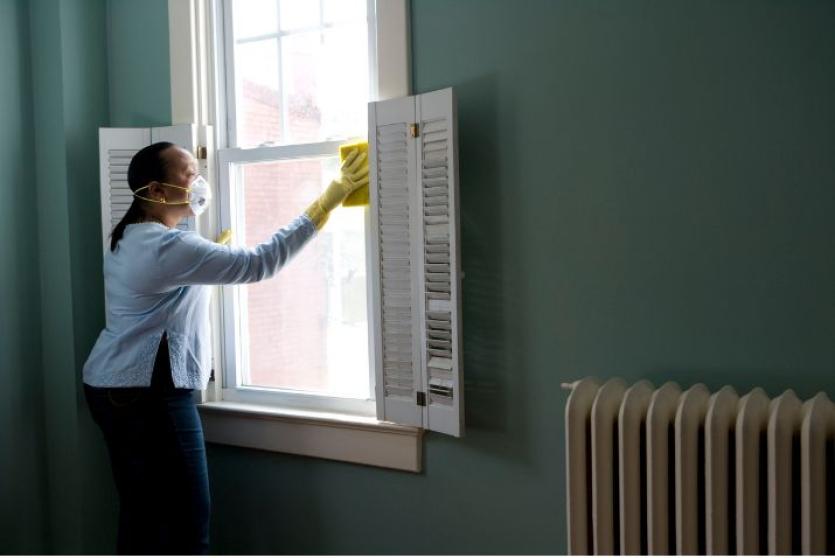- Home
- News and What's Going On At Leaders
- How you can help prevent damp and mould as a tenant
How you can help prevent damp and mould as a tenant

Damp and mould are common issues in rental properties, especially during the colder months. They not only look unsightly but can also lead to health problems if left untreated. As a tenant, it's important to understand how you can help prevent these issues from developing in your home. Here’s a guide on proactive steps you can take to reduce the risk of damp and mould:
1. Ventilate your home properly
One of the leading causes of damp and mould is a lack of proper ventilation. Everyday activities such as cooking, showering, and even drying clothes indoors create moisture in the air. Without good airflow, this moisture can condense on cool surfaces, creating the perfect environment for mould to grow. Here’s how to improve ventilation:
- Open windows regularly, especially after cooking or showering. This helps moisture escape and fresh air circulate.
- Use extractor fans in bathrooms and kitchens. If your property has these, make sure to turn them on whenever you’re using the stove or taking a shower.
- Leave internal doors open when possible, allowing air to flow throughout your home.

2. Control indoor humidity
Maintaining the right humidity levels is crucial for keeping your home mould-free. Too much moisture in the air will quickly lead to condensation. Here are some tips to manage humidity:
- Avoid drying clothes indoors. If possible, dry your laundry outside or in a well-ventilated area like a bathroom with a fan.
- Use a dehumidifier if you live in a particularly damp area. Dehumidifiers help to absorb excess moisture from the air.
- Keep furniture slightly away from walls. This allows air to circulate behind items like sofas or wardrobes, reducing the risk of condensation building up on walls.
3. Clean and treat affected areas quickly
If you do notice small patches of mould appearing, it's important to tackle them straight away before they spread. You can prevent mould from becoming a bigger problem by:
- Wiping away condensation daily, especially on windows or tiles in bathrooms and kitchens.
- Using a mould-resistant cleaner on affected areas. Spray the cleaner onto the mould and wipe it away with a cloth or sponge. Make sure to wear gloves and ventilate the room well while cleaning.
- Avoid covering mould with paint or wallpaper. This can trap moisture underneath and make the problem worse.

4. Heat your home consistently
Maintaining a steady temperature in your home can reduce the likelihood of condensation forming on cool surfaces. Sudden temperature drops can cause moisture to condense more easily.
- Keep your home at a consistent temperature. It doesn't have to be too high, but avoid letting rooms get too cold.
- Use central heating wisely. If you have control over your heating, try to heat your home for short periods regularly instead of cranking up the temperature occasionally.
5. Report any issues to your landlord
As a tenant, it's crucial to report any persistent or significant damp issues to your landlord or letting agent. Some issues, like structural problems or leaks, require professional intervention.
- Inform your landlord about leaks immediately, whether they’re from the roof, windows, or plumbing.
- Request repairs for cracked walls or damaged seals around windows and doors that could let in moisture.
- Keep records of your communications with your landlord or agent. If repairs aren't made in a reasonable time, you may need to escalate the issue.
6. Know your rights
If damp and mould persist despite your best efforts, you have the right to live in a property that is safe and free from health hazards. In England, for example, tenants are protected by the Homes (Fitness for Human Habitation) Act, which requires landlords to maintain properties in good condition.
Preventing damp and mould as a tenant requires a balance between proper ventilation, controlling humidity, and heating your home. However, some issues are beyond your control, such as structural problems or faulty appliances. By taking the steps outlined above and communicating effectively with your landlord, you can keep your home mould-free and comfortable.
If you're a tenant and have any questions about damp and mould, get in touch with your local branch who will be happy to help.
Looking for advice?
If you're looking to let or sell your property, we can help. Get in touch with your local branch or book in for a property valuation.

Contact Us
Got a question, general enquiry or something else?
You may also like
Since we started in 1983 we have grown to one of the UK’s largest property groups, we can save you time and money by offering a range of services and expertise under one roof.



